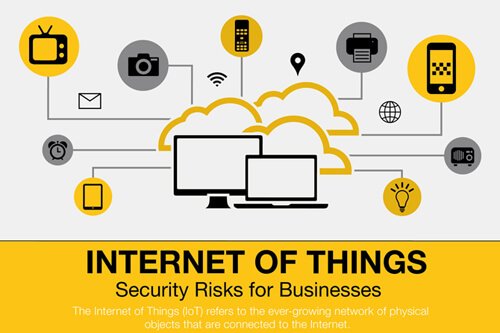internet of things risks
Internet of Things: Security Risks for Businesses [Infographic]

Internet of Things: Risks & Challenges

Securing the Internet of Things: Risks to Benefits

Abstract:
The Internet of Things (IoT) connects everyday things with sensors, software, and networks that enable them to collect and exchange data. While the IoT has opened up revolutionary new possibilities, it has also created security risks for businesses. This article examines the risks and challenges of the IoT and provides solutions for securing it.
Introduction:
The IoT has introduced a wave of new possibilities. However, by the same token, it has also introduced a range of security risks for businesses. Security risks associated with the IoT have become a major concern for businesses. Poorly secured IoT devices can provide an entry point for hackers to gain access to the company network, compromise sensitive data, and cause damage to the business. This article will delve into the various security risks posed by the IoT and will provide measures for mitigating those risks.
Content:
One of the most significant challenges associated with the IoT is the sheer number of devices that are currently in use. The more IoT devices are used, the greater the potential surface area for attack. The lack of security measures deployed in these devices makes them all the more vulnerable to hackers. For instance, IoT devices should receive regular security updates, but this is not always the case. This leaves them exposed to attacks that exploit known vulnerabilities.
Another risk factor that makes the IoT more vulnerable to attacks is the fact that most of the devices were not designed with security in mind. The primary focus for most developers was functionality, and security was an afterthought. This has left a gaping hole in the security of IoT devices. Thus, a large number of devices are easily breached by hackers. One example widely reported in the media is that of baby monitors being hacked, allowing the attacker to access live streams of the monitor.
Another security risk inherent in the IoT is the potential for data breaches to occur. IoT devices collect and transmit sensitive data. With the appropriate access, hackers could intercept this data in transit or steal it from the device. This leads to dangerous situations where private data can be spread across the internet, with disastrous consequences.
The use of IoT devices in critical infrastructure can also pose dangers. The internet has become integral to various critical applications such as healthcare, transportation, and manufacturing. The slightest disruption in the network can lead to massive failures. Hackers can also use the vulnerabilities in IoT devices to induce a failure in the entire system.
It is also important to note that the risks posed by the IoT are not limited to breaches by external sources. An insider threat is also a possibility. For instance, employees who have access to IoT devices could compromise the network intentionally or accidentally, leading to data breaches or even system failures.
Conclusion:
In conclusion, the IoT has brought revolutionary possibilities, but it has also introduced a range of security risks that businesses need to be aware of. It is important that businesses take measures to secure the IoT to ensure their networks, sensitive data, and other critical assets are not compromised. Businesses need to ensure they use devices that support regular security updates, design systems with security in mind from the get-go, encrypt critical data, and have measures to deal with insider threats. With the appropriate measures in place, businesses can benefit from the full potential of IoT while minimizing security risks.

Source image : www.coinspeaker.com

Source image : insights.samsung.com

Source image : cheekymunkey.co.uk


